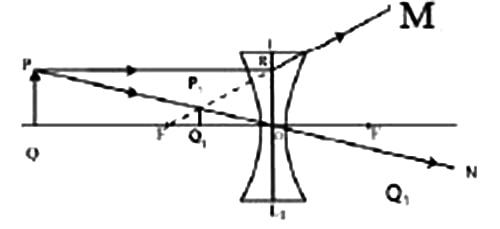Suppose LOL1 is a concave lens. FOF’ is its principal axis, O is its optical center and F is its principal focus. An extended object PQ is placed perpendicularly on the principal axis in front of the lens [figure]. The image of the object PQ is to be drawn.

A ray of light PR emitted from P parallel to the principal axis incidents at R and is refracted along RM in such a way that it appears that the ray is coming from principal focus F. Another my PO from P passes through the optical center 0′ and refracts straight along PON. These two refracted rays are divergent so they do not meet. If they are extended in the backward direction then it appears that they are coming from the point P1.
Now if we draw a perpendicular P1 Q1 on the principal axis from P1 then P1 Q1 will be the virtual image of PQ. This image is virtual, erect and smaller than the object in size. The concave lens always forms the image which is virtual, erect and smaller in size than the object.











